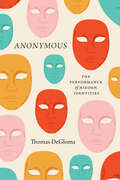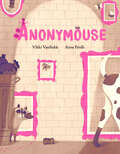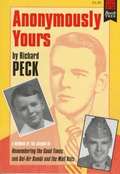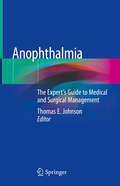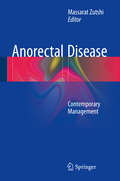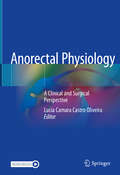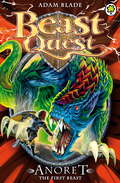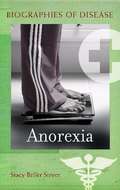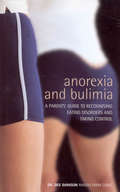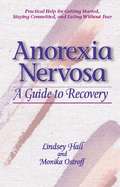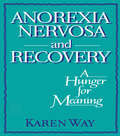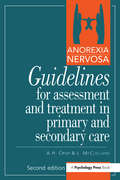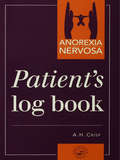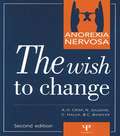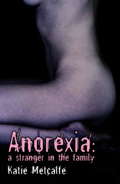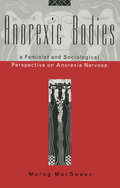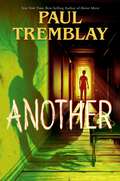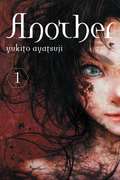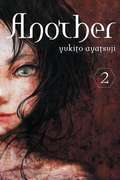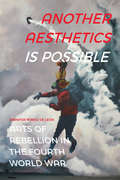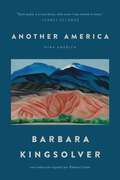- Table View
- List View
Anonymous: The Performance of Hidden Identities
by Thomas DeGlomaA rich sociological analysis of how and why we use anonymity. In recent years, anonymity has rocked the political and social landscape. There are countless examples: An anonymous whistleblower was at the heart of President Trump’s first impeachment, an anonymous group of hackers compromised more than 77 million Sony accounts, and best-selling author Elena Ferrante resolutely continued to hide her real name and identity. In Anonymous, Thomas DeGloma draws on a fascinating set of contemporary and historical cases to build a sociological theory that accounts for the many faces of anonymity. He asks a number of pressing questions about the social conditions and effects of anonymity. What is anonymity, and why, under various circumstances, do individuals act anonymously? How do individuals accomplish anonymity? How do they use it, and, in some situations, how is it imposed on them? To answer these questions, DeGloma tackles anonymity thematically, dedicating each chapter to a distinct type of anonymous action, including ones he dubs protective, subversive, institutional, and ascribed. Ultimately, he argues that anonymity and pseudonymity are best understood as performances in which people obscure personal identities as they make meaning for various audiences. As they bring anonymity and pseudonymity to life, DeGloma shows, people work to define the world around them to achieve different goals and objectives.
Anonymouse
by Vikki VanSickleAnimal-friendly street art is popping up all over the city, but who is creating these masterpieces? There is no explanation, only a name: Anonymouse. For fans of Sidewalk Flowers and Art & Max.Art for the birds. Art for the ants. Art for the dogs, cats and raccoons. Art to make them laugh, make them think, make them feel at home. But who is creating it? Only Anonymouse knows for sure . . .This clever tale mixes street art, animals and gorgeous illustrations to create a meditation on how art can uplift any creature's spirit -- human or animal -- when it speaks directly to them. Every page of Anna Pirolli's stunning artwork is its own masterpiece with its bold pops of colour and sly humor, elevating Vikki VanSickle's subtle but evocative text.
Anonymously Yours
by Richard PeckThe popular author describes how he grew up in Decatur, Illinois, went into teaching, and eventually became a writer, incorporating his earlier experiences into novels intended to reach and change young readers.
Anophthalmia: The Expert's Guide to Medical and Surgical Management
by Thomas E. JohnsonThis book provides a comprehensive review on the surgical care of patients requiring removal of an eye, as well as consequent functional and cosmetic rehabilitation. In addition to covering the crafting of ocular prosthetics, Anophthalmia: The Expert's Guide to Medical and Surgical Management also addresses the psychological and physical adjustments to losing an eye, and adapting to that loss.Divided into five parts, Anophthalmia functions as a go-to reference for ophthalmologists and oculoplastic surgeons. The book begins by laying out the clinical foundations and history of anophthalmia. Part II and III discuss surgical removal techniques, prosthesis fitting and maintenance, congenital anophthalmia, infections and inflammations, and newer surgical techniques such as osseointegration after orbital exenteration. Finally, the book concludes with chapters on prosthetic options including scleral shells, keratopigmentation procedures, and cosmetic contact lenses.Unique in content, Anophthalmia is a vital resource for practicing ophthalmologists, oculoplastic surgeons, and all medical professionals who care for patients with surgical and traumatic loss of the eye and orbital tissues. Additionally, sufficient detail and explanation make this work accessible to those in training, such as medical students, ophthalmology residents, and fellows.
Anorectal Disease: Contemporary Management
by Massarat ZutshiThis book provides a concise yet comprehensive summary of the current status of the field that guides patient management and stimulate investigative efforts. It is an easy reference for day-to-day anorectal pathology. The text reviews new testing procedures for anorectal diseases and provides new treatment options about anorectal disease both benign and malignant. All chapters are written by experts in their fields and include the most up-to-date scientific and clinical information. The text includes highly practical presentations of typical patients seen in the clinical practice of proctology in the form of case presentations with expert analysis and commentary. Example cases would include common but challenging cases such as an anal tumor, chronic anal pain and anal discharge. Anorectal Disease: Contemporary Management is a comprehensive, state-of-the-art review of this field and serves as a valuable resource for residents, clinicians, surgeons and researchers with an interest anorectal disease.
Anorectal Physiology: A Clinical and Surgical Perspective
by Lucia Camara Castro OliveiraThis is the first comprehensive book exclusively dedicated to anorectal physiology and the importance of diagnostic tools in guiding the evaluation and treatment of anorectal dysfunction. Functional disorders, and specifically fecal incontinence and evacuatory disorders, are prevalent in the general population, affecting up to 20% of individuals. As many of these conditions have extremely complex mechanisms, a thorough understanding of anorectal physiology is a crucial element in the surgeon’s “arsenal" to ensure accurate evaluation and to inform treatment. At this time, there is no other title that specifically addresses all aspects of anorectal physiology, as well as anorectal and pelvic floor disorders, including fecal incontinence and defecation disorders. Specifically, the book provides detailed descriptions of diagnostic methods and treatment algorithms for a range of anorectal conditions, including modern treatment modalities such as sacral neuromodulation.A unique and comprehensive reference covering all aspects of the evaluation and treatment of anorectal disorders, Anorectal Physiology – A Clinical and Surgical Perspective will be of significant interest to proctologists and coloproctologists, gastroenterologists, colorectal surgeons, gynecologists and all other professionals interested in anorectal physiology.
Anoret the First Beast: Special 12 (Beast Quest #12)
by Adam BladeBattle Beasts and fight Evil with Tom and Elenna in the bestselling adventure series for boys and girls aged 7 and up!Tom faces his greatest challenge yet: the legendary First Beast, Anoret, has been turned evil by the treacherous witch Kensa. Can Tom defeat an ancient terror before Avantia is ruined? If you like Beast Quest, check out Adam Blade's other series: Team Hero, Sea Quest and Beast Quest: New Blood!
Anorexia (Biographies of Disease)
by Stacy Beller StryerThis reference for high school and up examines the history and issues of anorexia nervosa, with special focus on sociocultural and economic changes over the past century that have contributed to anorexia. Coverage includes theories about causes of the condition, diagnostic criteria and warning signs, stages of the illness, characteristics of those who develop it, medical complications, early and modern treatments, prevention, and future research. Chapter-opening quotes from the diary of one high school student, along with brief excerpts from books by other sufferers, give readers an understanding of what it's like to have anorexia. Other features include a timeline, a list of online information sources and support organizations, and a glossary. Stryer is a pediatrician and consultant. Annotation ©2009 Book News, Inc., Portland, OR (booknews.com)
Anorexia And Bulimia: A Parent's Guide To Recognising Eating Disorders and Taking Control
by Dr Dee DawsonAnorexia nervosa is a condition in which sufferers diet continually and starve themselves. They may also use laxatives, vomiting or exercise excessively in order to control weight. Anorexia usually occurs in young women, starting in their teens, and it is estimated that about 2 per cent of all young women suffer from it. Bulimia is an eating disorder which is also on the rise among young people. They use the binge/purge cycle to extreme in their attempts to control their weight. This is a comprehensive, positive and practical guide to detecting the early signs of eating disorders and then curing them. Written with years of experience and expertise, it encourages parents to understand the illness, overcome their fears and take control of the situation, whether that means enforcing a strict meal plan or taking the decision to seek professional help. The book includes early signs to look out for; the possible effects of the illness, both physical and psychological; the treatments available and, most importantly, the plan, which helps parents to take positive action and really make a difference to their child's life.
Anorexia Nervosa
by Lindsey Hall Monika OstroffAnorexia nervosa, in simple terms, is self-starvation. However, it is a complex problem with intricate roots; and, recovery is best accomplished with a grasp of sound information, specific tasks, and the support of others. All of that is provided in this guidebook, which includes: Answers to questions most often asked Insight from recovered and recovering Monika Ostroff's story of recovery Specific things to do that have worked Information on healthy eating and weight Suggestions for how to stay committed A special section for parents & loved ones
Anorexia Nervosa and Recovery: A Hunger for Meaning
by Ellen Cole Esther D Rothblum Karly Way SchrammThrough the voices of twenty-one women, Karen Way presents the most objective, complete, and compassionate picture of what anorexia nervosa is about and, more importantly, of the complex individual variables and obstacles in the journey to recovery. From the premise that anorexia nervosa is an addiction--an obsession controlling all aspects of an individual’s life--and that complete recovery is possible by finding meaning in life, this enlightening book contrasts sharply to other books written on the subject by clinicians and theorists which merely speculate on the nature and etiology of anorexia nervosa. Anorexia Nervosa and Recovery lets the reader hear the personal struggles of women who have fought this powerful disease. They describe how anorexia controlled their lives and how, once they overcame their obsessions with food, weight, and thinness, they were able to lead fulfilling lives. This illuminating book encourages and inspires women who are in the throes of anorexia nervosa. They will recognize the emptiness in the voices and the descriptions of daily life. Therapists and clinicians who treat anorexic women will find intriguing chapters on events which trigger anorexia and what anorexics will do to maintain their strategies for coping. Concerned friends and family and others interested in understanding this controlling disease will be enlightened from this important and helpful book.
Anorexia Nervosa: A Recovery Guide for Sufferers, Families and Friends
by Janet Treasure June AlexanderThe highly respected and widely known Anorexia Nervosa: A Survival Guide for Sufferers and Friends was written in 1997. This long-awaited new edition builds on the work of the first book, providing essential new and updated research outcomes on anorexia nervosa. It offers a unique insight and guidance into the recovery process for those who suffer from an eating disorder as well as advice and information for their loved ones. Written collaboratively by both an expert in the field and someone with personal experience of eating disorders, this book offers exceptional understanding of the issues surrounding the illness. Divided into four sections, it includes: an outline of anorexia nervosa coping strategies for sufferers advice and information for families, carers and friends guidelines for professionals who are involved in the sufferer’s life. Families, friends, carers and professionals such as teachers and GPs are encouraged to read all sections in order to fully understand the illness. With an emphasis on collaboration and a layout that enables content to be referenced and read in any order, this book is an essential resource for anyone affected, directly or indirectly, by anorexia nervosa.
Anorexia Nervosa: Guidelines For Assessment & Treatment In Primary & Secondary Care
by A.H. CrispWe are delighted to publish this second edition of Anorexia Nervosa: Guidelines for Assessment and Treatment in Primary and Secondary Care, based on the first author's long-standing "St George's" Approach, which has been so well received since it was first published in 1994. The book aims to outline in a clear, practical way, the minimal intervention necessary within primary and secondary care settings if the psychopathology of this serious and life-threatening illness is first to be identified and then treated with some hope of success. This first attempt at a time-limited and basic meaningful intervention involves concurrent use by both patient and therapist (and also, to some extent, the family) of the 'self-help' book Anorexia Nervosa: The Wish to Change and the Patient's Log Book, and all three books can be purchased as a package.
Anorexia Nervosa: Patient's Log Book
by Professor A Crisp A.H. CrispThis log book brings together the in-patient version originally designed by Professor Arthur Crisp and Dr Kingsley Norton for use by people undergoing treatment in the Anorexia Nervosa Unit at Atkinson Morley's Hosptial, and the out-patient version published by Professor Crisp in 1993. The latter has been used by those attending the out-patient treatment programme of St George's Hospital Medical School and the related Highly Specialist Services section of Pathfinder Mental Health Services NHS Trust, and in other centres in the UK.The overall treatment programme is presented in the author's Anorexia Nervosa: Let me Be, first published in 1980 and now reprinted by Psychology Press.The Patient's Log Book is intended for both in-patient and out-patient use, as part of a clinically supervised treatment programme based on the "St George's" approach outlined in Anorexia Nervosa: Guidelines for Assessment and Treatment in Primary and Secondary Care.
Anorexia Nervosa: The Wish to Change
by Professor A. Crisp Neil Joughin Christine Halek Carol BowyerThis guide to 'self-help' has become highly valued by sufferers from anorexia nervosa, their families and their carers. It relates to Arthur Crisp's much praised text Anorexia Nervosa: Let Me Be, now in its third reprint. Many sufferers report that Anorexia Nervosa: The Wish to Change has provided them with their first private opportunity to reconsider their position and future properly, and then to do more about them. Carers have found it particularly helpful as a joint tool in their work with patients, especially when used alongside the more recently published Anorexia Nervosa: Guidelines for Assessment and Treatment in Primary and Secondary Care and the Patient's Log Book from the same centre.
Anorexia and Bulimia: Control That Is Out of Control (Hope for the Heart)
by June HuntFACT: About 50% of all people in the U.S. either know someone with an eating disorder or have been personally affected by one. Whether you are personally struggling with an eating disorder or you know someone who is, this 96-page book offers you key information on the causes, effects, and treatment options for anorexia and bulimia. It answers: What is anorexia and bulimia? What are the symptoms of anorexia? and How can someone recover from these eating disorders?Anorexia and bulimia feed the minds of those starving for love and acceptance with the wrong answer. But there's hope! After personally counseling people struggling with eating disorders for 30 years, June Hunt has seen firsthand that healing and recovery is possible. This quick-reference guide on eating disorders combines her years of experience with timeless biblical truth, relevant information, and practical action-steps. • Get key definitions, such as what is anorexia? What is anorexia nervosa? What is bulimia? What is "body image?"• Learn how to spot the symptoms of anorexia and the warning signs of bulimia. Find out how eating disorders damage the brain and body, causing everything from seizures, infertility, heart failure, and even death. • Discover the situational and root causes that often lead to eating disorders, such as unresolved pain.• Get practical advice on how to personally overcome an eating disorder or help guide someone through the process. Includes 8 "first steps" to take to begin your journey toward recovery and also gives practical ways to start eating healthier.• Dive into the Word of God and see what it says about your value, your image, and your worth. Be encouraged as you discover your incredible worth through God's eyes and be transformed as you align your thinking with God's thinking.Recommended resource for pastors, church leaders, youth leaders, children's ministry leaders, parents, concerned friends and family members.Make no mistake—anorexia and bulimia are life-threatening. Here's just a brief overview of the symptoms, signs, and effects of anorexia and bulimia. To find out more detail about the warning signs and how to help those struggling with an eating disorder, get June Hunt's Anorexia and Bulimia: Control That is Out of Control. What is Anorexia? Anorexia is an eating disorder characterized by compulsive, chronic self-starvation with a refusal to maintain a normal body weight.• What are the warning signs of anorexia? People who are anorexic deny ever feeling hungry. They diet and exercise excessively, feel bloated, fat, or nauseated from eating even small amounts of food; and they see themselves as fat when they are truly too thin. • What are some of the effects and symptoms of anorexia? • Damages the brain and nerves, causing disordered thinking, extreme forgetfulness, seizures, moodiness, irritability, and dizziness• Destroys their heart, kidneys, hair, blood fluid, intestines, muscles, joints, bones, hormones, teeth, and may even cause infertility. • Causes anxiety, depression, suicide, insomnia, and often causes those with anorexia to have a distorted view themselves (seeing themselves as fat even though they are "skin and bones") What is Bulimia?Bulimia is a psychological eating disorder characterized by repeated or sporadic "binge and purge" episodes. Bingeing involves eating large amounts of food in any setting in a short amount of time. Purging may be done by the intentional vomiting of food or by the use of laxatives and diuretics.• What are the warning signs of bulimia? People who are bulimic cope with emotional stress through overeating and then feel terrible afterward. They practice self-induced vomiting after eating. They often suffer from general depression; exercise excessively; and base self-worth on personal performance.• What are some of the effects and symptoms of bulimia? • Damages kidney, brain, lungs, and other vital organs. • Deteriorates teeth, esophagus, and stomach due to purging. Acid from stomach destroys teeth and causes gum disease, sores in the mouth, bleeding of the esopha
Anorexia: A Stranger in the Family
by Katie MetcalfeKatie Metcalfe takes readers through the daily struggle with this potentially lethal obsession. It is a harrowing account of her triumphs and tragedies on the long road to recovery after being hospitalized at 15. We learn of Katie's constant battle with 'the voice' when her pride at improving her health is overshadowed by the fear of over eating. It is a story of a young girl at war with herself and anyone who fights to keep her alive. However, Katie Metcalfe's book is more than a personal journey - it is the story of the impact of her illness on her family. With remarkable candour Katie's parents and siblings tell of the shocking impact on close relatives - when anorexia creates a stranger in the family. Katie's honesty combined with her talent for writing, gives a real sense of the horror of anorexia and its power to dominate lives. It is a true account of a family's hard won victory over a disease that kills.
Anorexia: A Stranger in the Family
by Katie MetcalfeKatie Metcalfe takes readers through the daily struggle with this potentially lethal obsession. It is a harrowing account of her triumphs and tragedies on the long road to recovery after being hospitalized at 15. We learn of Katie's constant battle with 'the voice' when her pride at improving her health is overshadowed by the fear of over eating.It is a story of a young girl at war with herself and anyone who fights to keep her alive. However, Katie Metcalfe's book is more than a personal journey - it is the story of the impact of her illness on her family.With remarkable candour Katie's parents and siblings tell of the shocking impact on close relatives - when anorexia creates a stranger in the family. Katie's honesty combined with her talent for writing, gives a real sense of the horror of anorexia and its power to dominate lives. It is a true account of a family's hard won victory over a disease that kills.
Anorexia: A Stranger in the Family
by Katie MetcalfeKatie Metcalfe takes readers through the daily struggle with this potentially lethal obsession. It is a harrowing account of her triumphs and tragedies on the long road to recovery after being hospitalized at 15. We learn of Katie's constant battle with 'the voice' when her pride at improving her health is overshadowed by the fear of over eating.It is a story of a young girl at war with herself and anyone who fights to keep her alive. However, Katie Metcalfe's book is more than a personal journey - it is the story of the impact of her illness on her family.With remarkable candour Katie's parents and siblings tell of the shocking impact on close relatives - when anorexia creates a stranger in the family. Katie's honesty combined with her talent for writing, gives a real sense of the horror of anorexia and its power to dominate lives. It is a true account of a family's hard won victory over a disease that kills.
Anorexic Bodies: A Feminist and Sociological Perspective on Anorexia Nervosa
by Morag MacSween Morag MacsweenThis book explores the ways in which anorexic women use their eating to control their bodies. It argues that the female body in modern Western culture is understood as open and accessible and female appetite as dangerous and voracious. Anorexia attempts to resist both these constructions in the creation of a closed, desireless body. Since anorexic women resist the power of collective ideologies their resistance cannot work - the closed body becomes its own prison.
Another
by Paul TremblayNew York Times bestselling, acclaimed horror author Paul Tremblay delivers an unforgettable middle grade debut in this bone-chilling tale of an unsettling, unbreakable friendship.“All the questions we ask as kids about who we are and what we’re worth take a terrifying turn in this spooky tale of a sinister, inhuman imposter and the nightmares he brings. Tremblay has taken the world of horror for adults by storm, and in his middle-grade debut, once again, he serves up scenes that will make you squirm long after the book is closed.” —M.T. Anderson, National Book Award WinnerWhen Casey Wilson’s parents tell him that his friend is coming for a sleepover, he has no idea who that might be. Ever since the Zoom Incident, everyone treats him like a pariah, and his tics are worse than ever. When Morel appears, he’s not like any friend Casey has ever met. His skin is like clay, and he doesn’t speak. But Casey’s parents are charmed by the strange kid, and it’s nice to have someone to talk to besides his sister, Ally, who is away at college. As his normally loving parents grow distant from Casey, they gush and fawn over Morel. Casey knows something is wrong—but with no end in sight to the sleepover, he’s exhausted. And in the dark, out of the corner of his eye, Morel doesn’t look like a kid at all. . . .
Another (Volume #1)
by Yukito AyatsujiIn the spring of 1998, Kouichi Sakakibara transfers to Yomiyama North Middle School. In class, he develops a sense of unease as he notices that the people around him act like they're walking on eggshells, and students and teachers alike seem frightened. As a chain of horrific deaths begin to unfold around him, he comes to discover that he has been placed in the cursed Class 3 in which the student body head count is always one more than expected. Class 3 is haunted by a vengeful spirit responsible for gruesome deaths in an effort to satisfy its spite. To stop the vicious cycle gripping his new school, Kouichi decides to get to the bottom of the curse, but is he prepared for the horror that lies ahead...?
Another (Volume #2)
by Yukito AyatsujiIn the spring of 1998, Kouichi Sakakibara transfers to Yomiyama North Middle School. In class, he develops a sense of unease as he notices that the people around him act like they're walking on eggshells, and students and teachers alike seem frightened. As a chain of horrific deaths begin to unfold around him, he comes to discover that he has been placed in the cursed Class 3 in which the student body head count is always one more than expected. Class 3 is haunted by a vengeful spirit responsible for gruesome deaths in an effort to satisfy its spite. To stop the vicious cycle gripping his new school, Kouichi decides to get to the bottom of the curse, but is he prepared for the horror that lies ahead...?
Another Aesthetics Is Possible: Arts of Rebellion in the Fourth World War (Dissident Acts)
by Jennifer Ponce de LeónIn Another Aesthetics Is Possible Jennifer Ponce de León examines the roles that art can play in the collective labor of creating and defending another social reality. Focusing on artists and art collectives in Argentina, Mexico, and the United States, Ponce de León shows how experimental practices in the visual, literary, and performing arts have been influenced by and articulated with leftist movements and popular uprisings that have repudiated neoliberal capitalism and its violence. Whether enacting solidarity with Zapatista communities through an alternate reality game or using surrealist street theater to amplify the more radical strands of Argentina's human rights movement, these artists fuse their praxis with forms of political mobilization from direct-action tactics to economic resistance. Advancing an innovative transnational and transdisciplinary framework of analysis, Ponce de León proposes a materialist understanding of art and politics that brings to the fore the power of aesthetics to both compose and make visible a world beyond capitalism.
Another America/Otra America
by Barbara KingsolverFrom a bestselling and beloved author, an intensely personal collection of poetry &“rich with political and human resonance&” (Ursula K. LeGuin)Before becoming the bestselling author we know today, Barbara Kingsolver, as a new college graduate in search of adventure, moved to the borderlands of Tucson, Arizona. What she found, she says, was &“another America.&”Interweaving past political events, from the US-backed dictatorships in South America to the government surveillance carried out in the Reagan years, Kingsolver&’s early poetry expands into a broader examination of the racism, discrimination, and immigration system she witnessed at close range. The poems coalesce in a record of her emerging adulthood, in which she confronts the hypocrisy of the national myth of America—a confrontation that would come to shape her not only as an artist, but as a citizen. With a new introduction from Kingsolver that reflects on the current border crisis, Another America is a striking portrait of a country deeply divided between those with privilege and those without, and the lives of urgent purpose that may be carved out in between.
